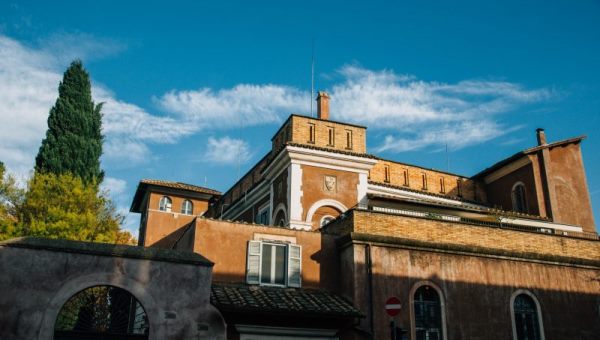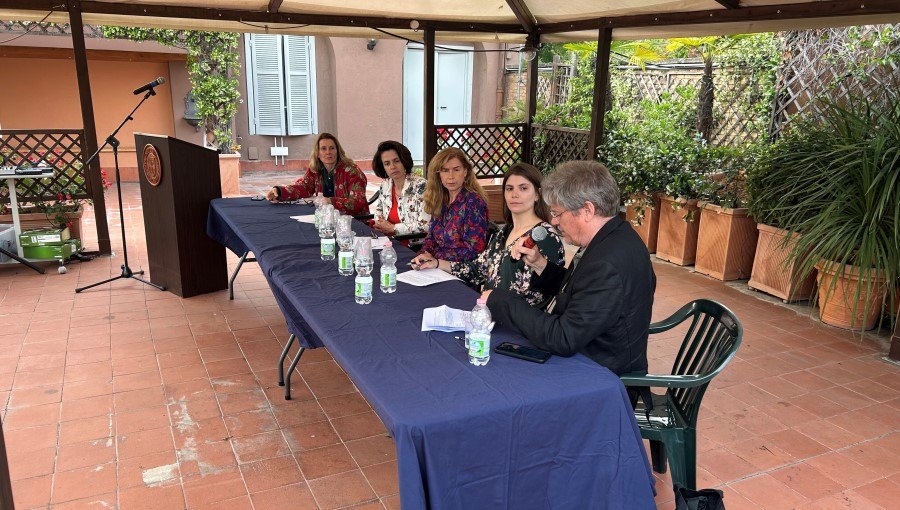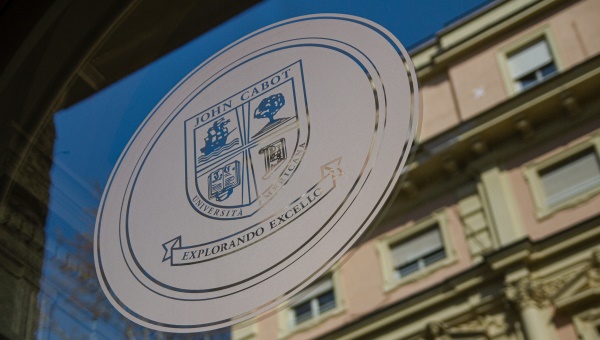Managing the Material Remnants of Fascism: a Book Presentation at JCU
On September 25, Professors Eszter Salgò, Sarah Linford, and Simon Martin discussed the book A Difficult Heritage: The Afterlives of Fascist-era Art and Architecture with the volume’s editor, Carmen Belmonte.

Fascist-era buildings (schools, post offices, banks, railway stations, government buildings) and artworks (mural paintings, easel paintings, mosaics, sculptures, reliefs) are ubiquitous in Italian cities, towns, and villages. The panelists’ starting assumption was that the survival of these sites can be read and treated in many different ways and that there is a need to raise awareness of the material remnants of the fascist era. Calling for a more open and vibrant debate on the fascist era’s legacy, the panelists argue, is not a call to “cancel” monuments, but to reframe them, critically.
Professor Eszter Salgò teaches in the Political Science and International Affairs Department. In her research, she explores the many links that exist between aesthetics and politics. She has recently submitted an article in which she analyzes the political dimension of the design of the Ethiopia Room in the Food and Agriculture Organization (FAO) headquarters in Rome, as a case study of decolonization and recolonization.
Professor Salgó stressed that different interpretations about how to treat surviving fascist-era art and architecture coexist, as do their silent absorption by the urban fabric and collective memory. She agrees with Mia Fuller and Hannah Malone who speak, respectively, of inertia memoriae and Italians’ difficulty in confronting a painful past. The book’s authors remind us, says Salgó, that there are various options between maintaining the status quo and demolition. For example, philological restoration and critical preservation represent two different ways of dealing with the material remains of the fascist era. Mario Sironi’s mural for the Aula Magna of La Sapienza University was restored in 2017 and its original fascist symbols were reinstated. The same year, in Bolzano, with the involvement of artists and the local community, an illuminated LED sign that read “No one has the right to obey” was superimposed on the monumental bas-relief of Mussolini on horseback and the fascist slogan “believe, obey, fight.” Adachiara Zevi shows how contemporary art can play an important role in subverting fascist rhetoric and how effective counter-monuments can be. For example, German artist Günter Demnig’s more than 100,000 stumbling stones, installed in front of the homes of those who had been deported between 1933 and 1945, transform an anonymous space into a place of remembrance, offering victims graves, headstones, and a symbolic memorial ceremony.

Professor Sarah Linford is an art historian and curator, specialized in modern and contemporary art; she works on what constitutes practice-based artistic research and on the relations between art and politics in the late 19th and 20th centuries. She is currently working with John Cabot alumnus Lindsay Maldari on the Viale dell’Impero at Rome’s Foro Italico, and specifically on the way its mosaics can be analyzed as the battleground between key fascist decision-makers, architects, artists, and institutions. Through comparative case studies, she has addressed some of the most pressing issues concerning contemporary artists’ attempts at the resignification of fascist monuments. Adding to the case studies in the volume’s section on “fascist Heritage and Contemporary Art,” she argued that scholarship on the “aesthetic quality” of fascist works has served to de-politicize them, and that the tendency to find elegant artistic solutions to this heritage may not be the way to prompt debates on collective memory. The contexts in which fascist-era sites and works were made are paramount, she insisted. Professor Linford addressed the question of memory negotiation, and the difference between the reappropriation/recontextualization of monuments, and their destruction, which is not the way forward but another form of forgetting. Tabula rasa is not the solution, and memory is fundamental. The allegedly neutral reuse or reconstruction of fascist-era art, art exhibitions, and architecture is a deeply problematic fiction. Linford concluded her intervention by calling into question the recent statement made by Vittorio Sgarbi about his ongoing “Arte e Fascismo” exhibition in Rovereto: “In Art, there is no Fascism, and in Fascism, there is no Art.” This, she argued, propagates, yet again, the misguided belief in the irrelevance of context to the artistic sphere.
Professor Simon Martin is a historian and interim academic director of the Rome Campus of Trinity College. His current research explores the cultural legacy and postwar memory of the fascist regime. His monograph examining the murder and memory of Giovanni Berta will be published in Italian by Laterza next month.
For Professor Martin, the volume includes many new voices and new approaches such as the concept of inertia memoriae: the idea that objects become harmless over time. The lack of any action has, over time, produced forgetting and defascistization. One of the problems with much of this material culture is the lack of context provided. An interesting operation, he explains, was done in the city of Forlí in the Emilia Romagna region: a Fascist building was restored, leaving intact the signs of iconoclasm. Could it be that historians and academics pay too much attention to these issues? Could it be that we are drawing attention to something that doesn’t need to be unraveled?
Carmen Belmonte is Assistant Professor of Contemporary Art History at Roma Tre University. Her research focuses on the visual culture and legacy of Italian colonialism and fascism, as well as on cultural heritage in contemporary Italy. She coordinates the research unit “Decolonizing Italian Visual and Material Culture,” co-funded by the Biblioteca Hertziana and the École Française de Rome. “The volume,” Belmonte explains, “was written in English to give an international scope to the research and to encourage a comparative perspective. It collects papers by fourteen scholars who have questioned the reasons for this survival through a comparative approach. Fascist artistic and monumental heritage, despite some examples of iconoclasm against images of Mussolini immediately after July 25, 1943, and some removal implemented in the process of defascistization, became part of the national cultural heritage in the 1980s. This is quite a different approach from what happened in other countries in which artistic and architectural expressions from controversial periods have been torn down or reinterpreted. One example is what happened in the United States where the wave of protest by popular movements initiated by African-American minorities about monuments and statues representative of white supremacism; another case is Germany: few Nazi buildings survived the bombings that destroyed most of the regime’s monuments, and those that have remained since the 1980s have been reinterpreted in a democratic manner, as shown for example in Berlin’s documentation center on the “Topography of Terror.”
The seminar was followed by a lively discussion and an aperitivo on the Secchia terrace.
Watch the recording of the event.
(Silvia Vettori, Eszter Salgò, Sarah Linford)





